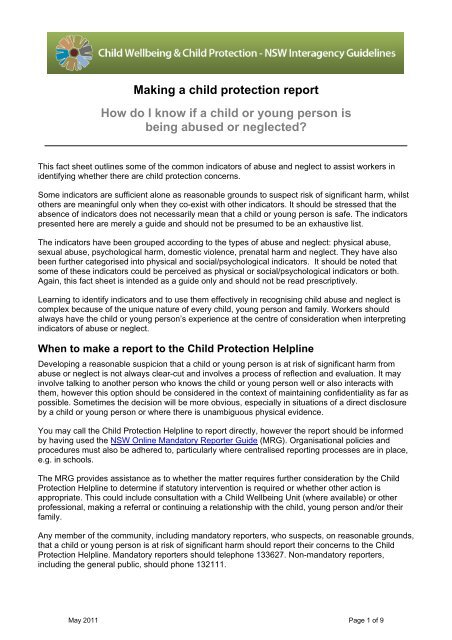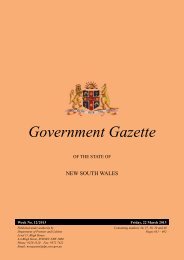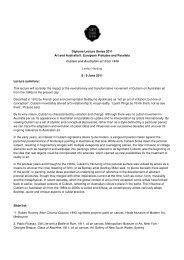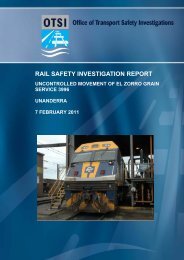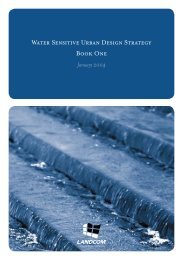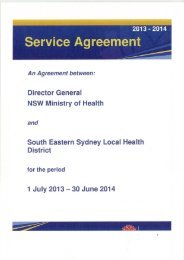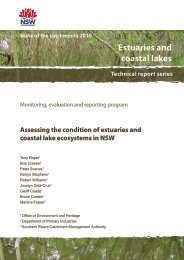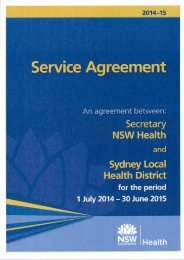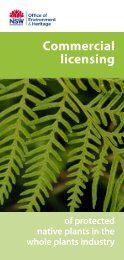How do I know if a child or young person is being abused or ...
How do I know if a child or young person is being abused or ...
How do I know if a child or young person is being abused or ...
Create successful ePaper yourself
Turn your PDF publications into a flip-book with our unique Google optimized e-Paper software.
Making a <strong>child</strong> protection rep<strong>or</strong>t<br />
<strong>How</strong> <strong>do</strong> I <strong>know</strong> <strong>if</strong> a <strong>child</strong> <strong>or</strong> <strong>young</strong> <strong>person</strong> <strong>is</strong><br />
<strong>being</strong> <strong>abused</strong> <strong>or</strong> neglected?<br />
Th<strong>is</strong> fact sheet outlines some of the common indicat<strong>or</strong>s of abuse and neglect to ass<strong>is</strong>t w<strong>or</strong>kers in<br />
ident<strong>if</strong>ying whether there are <strong>child</strong> protection concerns.<br />
Some indicat<strong>or</strong>s are sufficient alone as reasonable grounds to suspect r<strong>is</strong>k of sign<strong>if</strong>icant harm, whilst<br />
others are meaningful only when they co-ex<strong>is</strong>t with other indicat<strong>or</strong>s. It should be stressed that the<br />
absence of indicat<strong>or</strong>s <strong>do</strong>es not necessarily mean that a <strong>child</strong> <strong>or</strong> <strong>young</strong> <strong>person</strong> <strong>is</strong> safe. The indicat<strong>or</strong>s<br />
presented here are merely a guide and should not be presumed to be an exhaustive l<strong>is</strong>t.<br />
The indicat<strong>or</strong>s have been grouped acc<strong>or</strong>ding to the types of abuse and neglect: physical abuse,<br />
sexual abuse, psychological harm, <strong>do</strong>mestic violence, prenatal harm and neglect. They have also<br />
been further categ<strong>or</strong><strong>is</strong>ed into physical and social/psychological indicat<strong>or</strong>s. It should be noted that<br />
some of these indicat<strong>or</strong>s could be perceived as physical <strong>or</strong> social/psychological indicat<strong>or</strong>s <strong>or</strong> both.<br />
Again, th<strong>is</strong> fact sheet <strong>is</strong> intended as a guide only and should not be read prescriptively.<br />
Learning to ident<strong>if</strong>y indicat<strong>or</strong>s and to use them effectively in recogn<strong>is</strong>ing <strong>child</strong> abuse and neglect <strong>is</strong><br />
complex because of the unique nature of every <strong>child</strong>, <strong>young</strong> <strong>person</strong> and family. W<strong>or</strong>kers should<br />
always have the <strong>child</strong> <strong>or</strong> <strong>young</strong> <strong>person</strong>’s experience at the centre of consideration when interpreting<br />
indicat<strong>or</strong>s of abuse <strong>or</strong> neglect.<br />
When to make a rep<strong>or</strong>t to the Child Protection Helpline<br />
Developing a reasonable suspicion that a <strong>child</strong> <strong>or</strong> <strong>young</strong> <strong>person</strong> <strong>is</strong> at r<strong>is</strong>k of sign<strong>if</strong>icant harm from<br />
abuse <strong>or</strong> neglect <strong>is</strong> not always clear-cut and involves a process of reflection and evaluation. It may<br />
involve talking to another <strong>person</strong> who <strong>know</strong>s the <strong>child</strong> <strong>or</strong> <strong>young</strong> <strong>person</strong> well <strong>or</strong> also interacts with<br />
them, however th<strong>is</strong> option should be considered in the context of maintaining confidentiality as far as<br />
possible. Sometimes the dec<strong>is</strong>ion will be m<strong>or</strong>e obvious, especially in situations of a direct d<strong>is</strong>closure<br />
by a <strong>child</strong> <strong>or</strong> <strong>young</strong> <strong>person</strong> <strong>or</strong> where there <strong>is</strong> unambiguous physical evidence.<br />
You may call the Child Protection Helpline to rep<strong>or</strong>t directly, however the rep<strong>or</strong>t should be inf<strong>or</strong>med<br />
by having used the NSW Online Mandat<strong>or</strong>y Rep<strong>or</strong>ter Guide (MRG). Organ<strong>is</strong>ational policies and<br />
procedures must also be adhered to, particularly where central<strong>is</strong>ed rep<strong>or</strong>ting processes are in place,<br />
e.g. in schools.<br />
The MRG provides ass<strong>is</strong>tance as to whether the matter requires further consideration by the Child<br />
Protection Helpline to determine <strong>if</strong> statut<strong>or</strong>y intervention <strong>is</strong> required <strong>or</strong> whether other action <strong>is</strong><br />
appropriate. Th<strong>is</strong> could include consultation with a Child Well<strong>being</strong> Unit (where available) <strong>or</strong> other<br />
professional, making a referral <strong>or</strong> continuing a relationship with the <strong>child</strong>, <strong>young</strong> <strong>person</strong> and/<strong>or</strong> their<br />
family.<br />
Any member of the community, including mandat<strong>or</strong>y rep<strong>or</strong>ters, who suspects, on reasonable grounds,<br />
that a <strong>child</strong> <strong>or</strong> <strong>young</strong> <strong>person</strong> <strong>is</strong> at r<strong>is</strong>k of sign<strong>if</strong>icant harm should rep<strong>or</strong>t their concerns to the Child<br />
Protection Helpline. Mandat<strong>or</strong>y rep<strong>or</strong>ters should telephone 133627. Non-mandat<strong>or</strong>y rep<strong>or</strong>ters,<br />
including the general public, should phone 132111.<br />
May 2011 Page 1 of 9
Physical abuse<br />
Physical abuse occurs <strong>if</strong> a <strong>child</strong> <strong>or</strong> <strong>young</strong> <strong>person</strong> sustains a non-accidental injury <strong>or</strong> <strong>is</strong> <strong>being</strong> treated in<br />
a way that may have <strong>or</strong> <strong>is</strong> likely to cause injury. The injury may be inflicted by a parent, carer, other<br />
adult <strong>or</strong> <strong>child</strong> <strong>or</strong> <strong>young</strong> <strong>person</strong>.<br />
Potential Indicat<strong>or</strong>s of physical abuse<br />
In <strong>child</strong>ren & <strong>young</strong> people<br />
Physical<br />
bru<strong>is</strong>ing on the face, head <strong>or</strong> neck<br />
<br />
other bru<strong>is</strong>ing <strong>or</strong> marks showing the shape of<br />
the object that caused it<br />
In parents <strong>or</strong> caregivers<br />
Physical<br />
v<strong>is</strong>its with <strong>child</strong> to health <strong>or</strong> other services<br />
with unexplained <strong>or</strong> suspicious injuries,<br />
swallowing of non-food substances <strong>or</strong><br />
internal complaints<br />
<br />
<br />
<br />
<br />
lacerations and welts<br />
adult bite marks and scratches<br />
bone fractures <strong>or</strong> d<strong>is</strong>locations, especially in<br />
<strong>child</strong>ren under two years of age<br />
burn marks <strong>or</strong> scalds<br />
<br />
<br />
<br />
non-family member presents <strong>child</strong> to health<br />
services<br />
presentation at a number of d<strong>if</strong>ferent<br />
medical centres/services over time<br />
explanation of injury <strong>is</strong> not cons<strong>is</strong>tent with<br />
the v<strong>is</strong>ible injury<br />
<br />
<br />
multiple injuries <strong>or</strong> bru<strong>is</strong>es, maxilio-facial <strong>or</strong><br />
dental injury, f<strong>or</strong> example from f<strong>or</strong>ce feeding<br />
unspec<strong>if</strong>ied internal pains<br />
<br />
<br />
family h<strong>is</strong>t<strong>or</strong>y of violence<br />
d<strong>is</strong>closed/apparent use of excessive<br />
d<strong>is</strong>cipline<br />
<br />
<br />
explanation incons<strong>is</strong>tent with injury<br />
head injuries in infants where the infant may be<br />
drowsy <strong>or</strong> vomiting, <strong>or</strong> have glassy eyes, fixed<br />
pupils <strong>or</strong> pooling of blood in the eyes suggesting<br />
the possibility of having been shaken<br />
<br />
aggressive behaviour d<strong>is</strong>played in the<br />
presence of the <strong>child</strong> <strong>or</strong> <strong>young</strong> <strong>person</strong><br />
<br />
ingestion of po<strong>is</strong>onous substances, alcohol <strong>or</strong><br />
drugs<br />
<br />
behaves aggressively and violently towards<br />
others, particularly <strong>young</strong>er <strong>child</strong>ren<br />
<br />
physical indicat<strong>or</strong>s cons<strong>is</strong>tent with female<br />
genital mutilation<br />
Social/psychological<br />
wears clothing, inappropriate to the weather<br />
conditions, to conceal injuries<br />
<br />
direct <strong>or</strong> indirect d<strong>is</strong>closure of physical abuse<br />
Social/psychological<br />
h<strong>is</strong>t<strong>or</strong>y of their own maltreatment as a <strong>child</strong><br />
fears injuring their own <strong>child</strong><br />
<br />
<br />
explosive temper out of prop<strong>or</strong>tion to<br />
precipitating event<br />
fears going home <strong>or</strong> expresses a desire to live<br />
May 2011 Page 2 of 9
somewhere else<br />
<br />
<br />
<br />
<br />
lacks empathy<br />
general indicat<strong>or</strong>s cons<strong>is</strong>tent with female genital<br />
mutilation (e.g. having a ‘special operation <strong>or</strong><br />
ceremony’)<br />
constantly on guard around adults, cowers at<br />
sudden movements, unusually deferent to<br />
adults<br />
Aggression with peers and in play<br />
Sexual abuse<br />
Sexual abuse <strong>is</strong> sexual activity <strong>or</strong> behaviour that <strong>is</strong> imposed, <strong>or</strong> <strong>is</strong> likely to be imposed, on a <strong>child</strong> <strong>or</strong><br />
<strong>young</strong> <strong>person</strong> by another <strong>person</strong>. Sexual activity includes the following: sexual acts; exposure to<br />
sexually explicit material; inducing <strong>or</strong> coercing the <strong>child</strong> <strong>or</strong> <strong>young</strong> <strong>person</strong> to engage in, <strong>or</strong> ass<strong>is</strong>t any<br />
other <strong>person</strong> to engage in, sexually explicit conduct f<strong>or</strong> any reason and exposing the <strong>child</strong> <strong>or</strong> <strong>young</strong><br />
<strong>person</strong> to circumstances where there <strong>is</strong> r<strong>is</strong>k that they may be sexually <strong>abused</strong>.<br />
Potential Indicat<strong>or</strong>s of sexual abuse<br />
In victims<br />
In non-offending parents <strong>or</strong><br />
caregivers<br />
In perpetrat<strong>or</strong>s<br />
Physical<br />
pregnant and reluctant to<br />
ident<strong>if</strong>y father<br />
Physical<br />
nil<br />
Physical<br />
nil<br />
<br />
<br />
<br />
diagnosed sexually<br />
transmitted infection<br />
trauma to the genital region,<br />
including bru<strong>is</strong>ing, bleeding<br />
and tearing<br />
trauma to the breasts,<br />
buttocks, lower ab<strong>do</strong>men <strong>or</strong><br />
thighs including bite/burn<br />
marks<br />
Social/psychological<br />
direct <strong>or</strong> indirect d<strong>is</strong>closure<br />
of sexual abuse<br />
<br />
<br />
<br />
contact with an alleged <strong>or</strong><br />
<strong>know</strong>n sex offender<br />
describes <strong>or</strong> re-enacts<br />
sexual acts with age<br />
inappropriate <strong>know</strong>ledge<br />
unexplained money <strong>or</strong> g<strong>if</strong>ts<br />
Social/psychological<br />
defers to partner<br />
may minim<strong>is</strong>e d<strong>is</strong>closure<br />
Social/psychological<br />
appears to encourage,<br />
tolerate sexual<strong>is</strong>ed behaviour<br />
<br />
<br />
controlling attitude and<br />
behaviour to <strong>child</strong>, <strong>young</strong><br />
<strong>person</strong> and/<strong>or</strong> partner<br />
exposes <strong>child</strong> <strong>or</strong> <strong>young</strong><br />
<strong>person</strong> to prostitution <strong>or</strong><br />
p<strong>or</strong>nography, <strong>or</strong> uses a <strong>child</strong><br />
<strong>or</strong> <strong>young</strong> <strong>person</strong> f<strong>or</strong><br />
p<strong>or</strong>nographic purposes<br />
May 2011 Page 3 of 9
sexually provocative<br />
r<strong>is</strong>k taking behaviours, self<br />
harm, suicidal ideation and<br />
alcohol <strong>or</strong> drug use<br />
po<strong>or</strong> self esteem<br />
<br />
<br />
intentionally exposes <strong>child</strong> <strong>or</strong><br />
<strong>young</strong> <strong>person</strong> to the sexual<br />
behaviour of others<br />
committed <strong>or</strong> has been<br />
suspected of <strong>child</strong> sexual<br />
abuse <strong>or</strong> <strong>child</strong> p<strong>or</strong>nography<br />
<br />
<br />
d<strong>is</strong>turbed sleep and<br />
nightmares<br />
marked changes in<br />
behaviour, f<strong>or</strong> example a<br />
confident talkative <strong>child</strong><br />
becoming suddenly<br />
introverted, <strong>or</strong> an introverted<br />
<strong>child</strong> becoming aggressive<br />
<strong>or</strong> not wanting to be alone<br />
<br />
<br />
coerces <strong>child</strong> <strong>or</strong> <strong>young</strong><br />
<strong>person</strong> to engage in sexual<br />
behaviour with other <strong>child</strong>ren<br />
and <strong>young</strong> people<br />
minim<strong>is</strong>es d<strong>is</strong>closure <strong>or</strong><br />
defends against accusations<br />
of sexual abuse by claiming<br />
the <strong>child</strong> <strong>or</strong> <strong>young</strong> <strong>person</strong> <strong>is</strong><br />
lying<br />
<br />
<br />
<br />
<br />
eating d<strong>is</strong><strong>or</strong>der<br />
regresses in developmental<br />
achievements, <strong>child</strong> <strong>is</strong><br />
excessively clingy <strong>or</strong> begins<br />
soiling and wetting when<br />
these were not f<strong>or</strong>merly a<br />
problem<br />
sexual themes in the <strong>child</strong>'s<br />
artw<strong>or</strong>k, st<strong>or</strong>ies <strong>or</strong> play<br />
fears going home <strong>or</strong><br />
expresses a desire to live<br />
elsewhere<br />
<br />
<br />
<br />
<br />
<br />
inappropriately curtails<br />
development of <strong>child</strong>’s age<br />
appropriate independence<br />
from the family<br />
overly critical of adult partner<br />
family denies pregnancy of<br />
<strong>child</strong> <strong>or</strong> <strong>young</strong> <strong>person</strong><br />
minim<strong>is</strong>ation of the impact <strong>or</strong><br />
seriousness of abuse<br />
just<strong>if</strong>ication of abuse by<br />
blaming victim<br />
<br />
pers<strong>is</strong>tently runs away from<br />
home<br />
<br />
grooming behaviour<br />
<br />
goes to bed fully clothed<br />
<br />
wears baggy clothes in<br />
<strong>or</strong>der to d<strong>is</strong>gu<strong>is</strong>e gender,<br />
body shape, bru<strong>is</strong>ing <strong>or</strong><br />
injuries<br />
<br />
engages in, talks about<br />
sexual acts including violent<br />
sexual acts<br />
<br />
<strong>know</strong>s about practices and<br />
locations usually associated<br />
with prostitution<br />
May 2011 Page 4 of 9
Psychological harm<br />
The <strong>child</strong> <strong>or</strong> <strong>young</strong> <strong>person</strong>’s psychological state has been, <strong>or</strong> <strong>is</strong> at r<strong>is</strong>k of, <strong>being</strong> harmed, because of<br />
the parent <strong>or</strong> carer’s behaviour <strong>or</strong> attitude. Th<strong>is</strong> could be due to <strong>do</strong>mestic violence, mental health,<br />
drug and alcohol use, criminal <strong>or</strong> c<strong>or</strong>rupting behaviour <strong>or</strong> deliberate exposure to traumatic events.<br />
Potential Indicat<strong>or</strong>s of psychological harm<br />
In <strong>child</strong>ren & <strong>young</strong> people<br />
Physical<br />
self-harms, attempts suicide<br />
In parents <strong>or</strong> caregivers<br />
Physical<br />
uses inappropriate physical <strong>or</strong> social <strong>is</strong>olation<br />
as pun<strong>is</strong>hment<br />
<br />
presence of <strong>do</strong>mestic violence<br />
Social/psychological<br />
feels w<strong>or</strong>thless, low self esteem, not<br />
confident<br />
Social/psychological<br />
constantly critic<strong>is</strong>es, belittles, teases<br />
<strong>child</strong>/<strong>young</strong> <strong>person</strong><br />
<br />
<br />
<br />
<br />
<br />
takes extreme r<strong>is</strong>ks, <strong>is</strong> markedly d<strong>is</strong>ruptive, <strong>is</strong><br />
a bully, <strong>is</strong> aggressively violent<br />
regresses in developmental achievements,<br />
<strong>child</strong> <strong>is</strong> excessively clingy <strong>or</strong> begins soiling<br />
and wetting when these were not f<strong>or</strong>merly a<br />
problem<br />
<strong>do</strong>esn’t value others <strong>or</strong> show empathy<br />
lacks trust in people<br />
lacks age appropriate inter<strong>person</strong>al skills<br />
<br />
<br />
<br />
<br />
<br />
<br />
ign<strong>or</strong>es <strong>or</strong> withholds pra<strong>is</strong>e and affection<br />
pers<strong>is</strong>tently hostile and verbally abusive,<br />
rejects and blames <strong>child</strong> unnecessarily<br />
makes excessive <strong>or</strong> unreasonable demands<br />
presence of <strong>do</strong>mestic violence<br />
unmanaged mental health condition<br />
believes that a particular <strong>child</strong> <strong>or</strong> <strong>young</strong><br />
<strong>person</strong> <strong>is</strong> bad <strong>or</strong> evil<br />
<br />
<br />
extreme attention seeking<br />
impaired parental <strong>or</strong> caregiver attachment<br />
<br />
<strong>is</strong>olates and/<strong>or</strong> prevents the <strong>child</strong> <strong>or</strong> <strong>young</strong><br />
<strong>person</strong> from engaging in n<strong>or</strong>mal peer<br />
relationships<br />
<br />
<br />
depressed, anxious <strong>or</strong> other mental health<br />
indicat<strong>or</strong>s<br />
avoids adults<br />
<br />
unable to respond to the psychological needs<br />
of the <strong>child</strong> <strong>or</strong> <strong>young</strong> <strong>person</strong> due to their own<br />
drug and/<strong>or</strong> alcohol use<br />
<br />
obsessively flattering, subm<strong>is</strong>sive to adults<br />
<br />
has d<strong>if</strong>ficulty maintaining long term sign<strong>if</strong>icant<br />
relationships<br />
<br />
highly self-critical<br />
<br />
d<strong>is</strong>plays rocking, sucking, head-banging<br />
behaviour<br />
May 2011 Page 5 of 9
Domestic and family violence<br />
Domestic and family violence <strong>is</strong> any abusive behaviour used by a <strong>person</strong> in a relationship to gain and<br />
maintain control over their partner <strong>or</strong> ex-partner. It can include a broad range of behaviour that<br />
causes fear and physical and/<strong>or</strong> psychological harm. If a <strong>child</strong> <strong>or</strong> <strong>young</strong> <strong>person</strong> <strong>is</strong> living in a<br />
household where there have been incidents of <strong>do</strong>mestic violence, then they may be at r<strong>is</strong>k of serious<br />
physical and/<strong>or</strong> psychological harm.<br />
Potential Indicat<strong>or</strong>s of parent/carer <strong>do</strong>mestic violence<br />
In <strong>child</strong>ren & <strong>young</strong> people In adult victims In perpetrat<strong>or</strong>s<br />
Physical<br />
preterm and low birth weight<br />
baby<br />
<br />
low weight f<strong>or</strong> age and/<strong>or</strong><br />
fails to thrive and develop<br />
Physical<br />
explanation incons<strong>is</strong>tent with<br />
injury<br />
<br />
bru<strong>is</strong>ing and other injuries,<br />
especially <strong>if</strong> pregnant<br />
Physical<br />
physical signs of the victim<br />
fighting back, such as facial<br />
scratches and injuries to<br />
hands<br />
<br />
<br />
<br />
unexplained physical injuries<br />
uses <strong>or</strong> abuses alcohol <strong>or</strong><br />
other drugs<br />
eating d<strong>is</strong><strong>or</strong>ders<br />
<br />
<br />
minim<strong>is</strong>es injuries and/<strong>or</strong><br />
pain<br />
wears concealing clothing,<br />
in <strong>or</strong>der to hide bru<strong>is</strong>ing <strong>or</strong><br />
injuries<br />
<br />
<br />
<br />
psychosomatic complaints<br />
aggressive <strong>or</strong> violent<br />
behaviour<br />
regresses in developmental<br />
achievements, pre-school<br />
<strong>child</strong> <strong>is</strong> excessively clingy <strong>or</strong><br />
begins soiling and wetting<br />
when these were not<br />
f<strong>or</strong>merly a problem<br />
<br />
<br />
<br />
unwanted pregnancy <strong>or</strong><br />
sexually transmitted<br />
infection through coerced<br />
sex/refusal by sexual<br />
partner to use contraception<br />
unexplained m<strong>is</strong>carriage <strong>or</strong><br />
stillbirth<br />
alcohol and/<strong>or</strong> drug abuse<br />
<br />
wears concealing clothing, in<br />
<strong>or</strong>der to hide bru<strong>is</strong>ing <strong>or</strong><br />
injuries<br />
Social/psychological<br />
directly <strong>or</strong> indirectly d<strong>is</strong>closes<br />
<strong>do</strong>mestic violence<br />
Social/psychological<br />
nutritional and sleep<br />
deprivation <strong>or</strong> d<strong>is</strong><strong>or</strong>ders<br />
Social/psychological<br />
directly <strong>or</strong> indirectly<br />
d<strong>is</strong>closes <strong>do</strong>mestic violence<br />
<br />
<br />
<br />
d<strong>if</strong>ficulties with sleeping,<br />
eating<br />
over-protects mother <strong>or</strong> fears<br />
leaving mother at home<br />
no <strong>or</strong> little emotion <strong>or</strong> fear<br />
when hurt <strong>or</strong> threatened<br />
<br />
<br />
<br />
<br />
feels anxious and depressed<br />
low self-esteem<br />
socially <strong>is</strong>olated<br />
d<strong>is</strong>closure of suicidal<br />
thoughts and attempts<br />
<br />
<br />
<br />
presents as the victim<br />
v<strong>is</strong>ible rough handling of<br />
victim, <strong>child</strong>ren, pets<br />
threatens to commit acts of<br />
violence against family<br />
members <strong>or</strong> pets<br />
<br />
unusual fear of physical<br />
<br />
subm<strong>is</strong>sive and withdrawn<br />
<br />
<strong>is</strong> unable to control angry<br />
May 2011 Page 6 of 9
contact with adults<br />
overly compliant, shy,<br />
withdrawn, passive and<br />
uncommunicative<br />
po<strong>or</strong> sleeping patterns, fear<br />
of dark, nightmares<br />
frequent school<br />
absentee<strong>is</strong>m, po<strong>or</strong><br />
concentration<br />
po<strong>or</strong> academic achiever<br />
insecure attachment with<br />
parents<br />
physically, verbally abusive<br />
towards siblings, parents and<br />
peers<br />
abusive <strong>or</strong> d<strong>is</strong>m<strong>is</strong>sive<br />
attitude to a parent who <strong>is</strong> a<br />
victim<br />
homeless <strong>or</strong> stays away from<br />
home f<strong>or</strong> prolonged time<br />
<br />
<br />
<br />
<br />
<br />
<br />
<br />
sel<strong>do</strong>m <strong>or</strong> never makes<br />
dec<strong>is</strong>ions without referring to<br />
partner<br />
frequent absences from<br />
w<strong>or</strong>k <strong>or</strong> studies<br />
substantial delay bef<strong>or</strong>e<br />
seeking medical treatment<br />
repeat/after hours<br />
presentations at emergency<br />
departments<br />
terr<strong>or</strong> <strong>or</strong> reluctance to speak<br />
to those in auth<strong>or</strong>ity<br />
reference frequently made<br />
to a partner’s anger <strong>or</strong><br />
temper<br />
financial problems<br />
<br />
<br />
<br />
<br />
<br />
<br />
<br />
outbursts<br />
always speaks f<strong>or</strong> partner<br />
<strong>or</strong> <strong>child</strong>ren<br />
describes partner as<br />
incompetent <strong>or</strong> stupid<br />
holds rigidly to stereotypical<br />
gender roles<br />
jealous of partner, lacks<br />
trust in them <strong>or</strong> anyone else<br />
<strong>do</strong>es not allow partner <strong>or</strong><br />
<strong>child</strong> to access service<br />
providers alone<br />
admits to some violence<br />
but minim<strong>is</strong>es its frequency<br />
and severity<br />
previous criminal<br />
convictions <strong>or</strong> apprehended<br />
violence <strong>or</strong>ders imposed<br />
against them<br />
<br />
takes extreme r<strong>is</strong>ks<br />
<br />
socially <strong>is</strong>olated<br />
<br />
sadness and frequent crying<br />
<br />
suicide attempts<br />
May 2011 Page 7 of 9
Neglect<br />
The <strong>child</strong> <strong>or</strong> <strong>young</strong> <strong>person</strong>’s basic needs (e.g. superv<strong>is</strong>ion, medical care, nutrition, shelter and<br />
education) have not been met, <strong>or</strong> are at r<strong>is</strong>k of not <strong>being</strong> met, to such an extent that it can reasonably<br />
be expected to have a sign<strong>if</strong>icant adverse impact on the <strong>child</strong> <strong>or</strong> <strong>young</strong> <strong>person</strong>’s safety, welfare <strong>or</strong><br />
well-<strong>being</strong>. Th<strong>is</strong> lack of care could be constituted by a single act <strong>or</strong> om<strong>is</strong>sion <strong>or</strong> a pattern of acts <strong>or</strong><br />
om<strong>is</strong>sions.<br />
Potential indicat<strong>or</strong>s of neglect<br />
In <strong>child</strong>ren & <strong>young</strong> people<br />
Physical<br />
low weight f<strong>or</strong> age and/<strong>or</strong> fails to thrive and<br />
develop<br />
In parents <strong>or</strong> caregivers<br />
Physical<br />
may have po<strong>or</strong> standards of hygiene and self<br />
care<br />
<br />
inappropriate prov<strong>is</strong>ion of nutrition leading to,<br />
f<strong>or</strong> example, excessive weight f<strong>or</strong> age<br />
<br />
physical signs of injuries from <strong>do</strong>mestic<br />
violence<br />
<br />
<br />
<br />
attains general developmental milestones late<br />
po<strong>or</strong> primary health care, untreated s<strong>or</strong>es,<br />
serious nappy rash, sign<strong>if</strong>icant dental decay<br />
standard of hygiene and self-care <strong>is</strong> po<strong>or</strong><br />
<br />
<br />
pri<strong>or</strong>it<strong>is</strong>ation of w<strong>or</strong>k and adult interests to<br />
essential needs of <strong>child</strong> <strong>or</strong> <strong>young</strong> <strong>person</strong><br />
parental drug <strong>or</strong> alcohol use <strong>or</strong> dependence<br />
having a negative impact on the <strong>child</strong>’s<br />
physical, social and psychological health<br />
<br />
not adequately superv<strong>is</strong>ed f<strong>or</strong> their age<br />
Social/psychological<br />
scavenges <strong>or</strong> steals food, focus <strong>is</strong> on basic<br />
survival<br />
<br />
longs f<strong>or</strong> <strong>or</strong> ind<strong>is</strong>criminately seeks adult<br />
affection<br />
Social/psychological<br />
unable <strong>or</strong> unwilling to provide <strong>or</strong> arrange<br />
adequate food, shelter, clothing, education,<br />
medical attention <strong>or</strong> a safe home<br />
<br />
leaves <strong>child</strong> without appropriate superv<strong>is</strong>ion<br />
<br />
po<strong>or</strong> school attendance<br />
<br />
aban<strong>do</strong>ns <strong>child</strong><br />
<br />
<br />
<br />
stays at the homes of friends and<br />
acquaintances f<strong>or</strong> prolonged periods, rather<br />
than at own home<br />
d<strong>is</strong>plays rocking, sucking, head-banging<br />
behaviour<br />
overly passive, emotionless<br />
<br />
<br />
<br />
<br />
withholds physical contact <strong>or</strong> stimulation f<strong>or</strong><br />
prolonged periods<br />
minimal psychological nurturing, ‘low-warmth’<br />
parenting<br />
limited understanding of <strong>child</strong>’s needs<br />
unreal<strong>is</strong>tic expectations of <strong>child</strong><br />
<br />
presence of an unmanaged mental health<br />
condition<br />
<br />
treats one <strong>child</strong> d<strong>if</strong>ferently to other siblings<br />
May 2011 Page 8 of 9
Prenatal harm<br />
Refers to parental circumstances <strong>or</strong> behaviours during pregnancy that may reasonably be expected<br />
to produce a substantial and demonstrably adverse impact on the <strong>child</strong>’s safety, welfare <strong>or</strong> well<strong>being</strong>.<br />
Potential indicat<strong>or</strong>s of prenatal harm<br />
In parents <strong>or</strong> caregivers<br />
Physical<br />
<br />
pregnant woman m<strong>is</strong>uses alcohol <strong>or</strong> drugs<br />
<br />
<br />
pregnant woman <strong>is</strong>/has been victim of <strong>do</strong>mestic violence<br />
homelessness<br />
Social/psychological<br />
<br />
pregnant woman has an unmanaged mental health condition<br />
<br />
<br />
<br />
<br />
<br />
<br />
pregnant woman <strong>is</strong> at r<strong>is</strong>k of suicide<br />
pregnant woman <strong>or</strong> caregivers have h<strong>is</strong>t<strong>or</strong>y of abuse <strong>or</strong> neglect of siblings of the unb<strong>or</strong>n <strong>child</strong><br />
a previous <strong>child</strong> of the pregnant woman was removed <strong>or</strong> died<br />
pregnant woman’s partner had a previous <strong>child</strong> removed <strong>or</strong> die in suspicious circumstances<br />
pregnant woman’s sign<strong>if</strong>icant others are m<strong>is</strong>using drugs, alcohol <strong>or</strong> have a mental illness<br />
pregnant <strong>child</strong> <strong>or</strong> <strong>young</strong> <strong>person</strong> with limited social supp<strong>or</strong>t, such as pregnant <strong>child</strong>/<strong>young</strong> <strong>person</strong><br />
under parental responsibility to the Min<strong>is</strong>ter<br />
May 2011 Page 9 of 9


